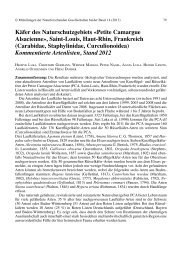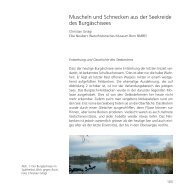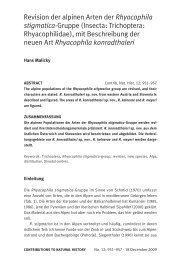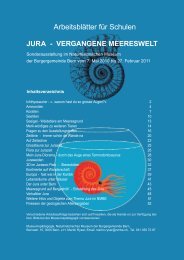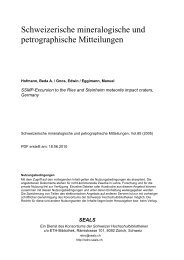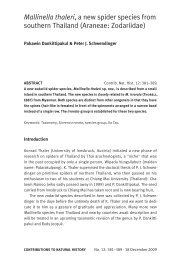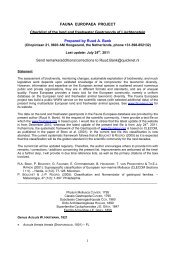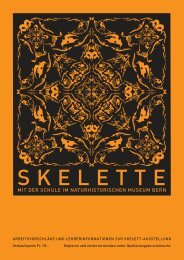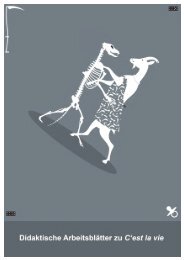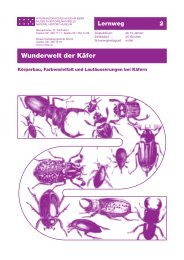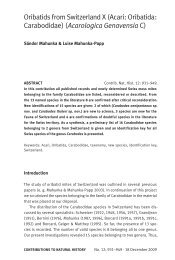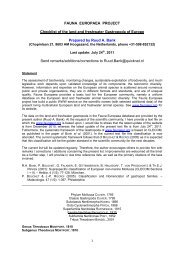Biharotrechus - Naturhistorisches Museum Bern
Biharotrechus - Naturhistorisches Museum Bern
Biharotrechus - Naturhistorisches Museum Bern
You also want an ePaper? Increase the reach of your titles
YUMPU automatically turns print PDFs into web optimized ePapers that Google loves.
Two new subterranean, microphthalmous<br />
trechine beetles from the Mediterranean<br />
area, and a synonymic note (Coleoptera:<br />
Carabidae, Trechini)<br />
Achille Casale<br />
ABSTRACT Contrib. Nat. Hist. 16: 1–16.<br />
Duvalius (<strong>Biharotrechus</strong>) huberi sp. nov. from Southern Turkey (Toros chain, Geyik<br />
Dağı Mt.), sampled at high altitude near the snow, is described and illustrated. Its<br />
relationships are discussed: in particular, the new species seems to be the adelpho-<br />
taxon of D. (B.) bortesii Casale & Vigna Taglianti, 1984, and forms with the latter<br />
an isolated, Anatolian lineage within a Duvalius group widely spread in the Balkan<br />
peninsula and the Carpathians.<br />
Trechus (Trechus) messoulii sp. nov. from Northern Morocco (Rif massif, Taza,<br />
Toghobeit cave), sampled in one of the deepest caves of Africa, is described and<br />
illustrated. Its morphological features, both external and in male genitalia, are very<br />
close to those of Trechus of the fulvus species group, and of Rifean species currently<br />
attributed to genus Antoinella Jeannel.<br />
The significance of these characters, in a both taxonomic and biogeographical con-<br />
text, is discussed, and the new synonymy is here proposed:<br />
Antoinella Jeannel, 1937 = Trechus Clairville, 1806, new synonymy.<br />
Keywords: Coleoptera, Carabidae, Trechini, Duvalius huberi, new species, Turkey, Trechus<br />
messoulii, new species, Morocco, Antoinella, new synonymy.<br />
Introduction<br />
The discovery of new subterranean taxa in the Euro-Mediterranean area is frequent,<br />
and their descriptions are a current, every-day taxonomical practice.<br />
Nevertheless, some of these taxa are particularly interesting, because their<br />
morphological features, and their geographical patterns of distribution, permit<br />
postulating the history and evolution of some lineages, and better understanding<br />
the taxonomic position of previously described relatives.<br />
CONTRIBUTIONS TO NATURAL HISTORY No. 16: 1–16 · 17 March 2011
This is the case of two new subterranean, microphthalmous trechine species<br />
here described, originating from Southern Turkey (Anatolia, Toros chain)<br />
and Northern Morocco (Rif massif), respectively.<br />
Material and methods<br />
The following data come from two examined male individuals (see: Type<br />
Material).<br />
Male genitalia were dissected, dehydrated in ethanol, cleared in cold KOH,<br />
and examined and illustrated, using standard techniques before being mounted<br />
on microscope slides attached to the respective specimens.<br />
Line drawings were made using a camera lucida attached to stereomicroscopes<br />
Wild M-3 and Wild M-5, and a microscope Leitz Orthoplan.<br />
Acronyms of measurements:<br />
TL: body Total Length, from the anterior margin of clypeus to the apex of<br />
elytra, measured along the suture.<br />
L: overall Length, from apex of mandibles to apex of elytra, measured along<br />
the suture.<br />
PL/PW: ratio Length of Pronotum, as linear distance from the anterior to the<br />
basal margin, measured along the midline/maximum Width of Pronotum,<br />
as greatest transverse distance.<br />
EL/EW: ratio Length of Elytra, as linear distance from the basal ridge to the<br />
apex, measured along the suture/maximum Width of Elytra.<br />
Collections:<br />
NMBE <strong>Naturhistorisches</strong> <strong>Museum</strong> der Burgergemeinde <strong>Bern</strong> (Switzerland)<br />
CCa Casale collection, Torino (Italy)<br />
Results<br />
Duvalius (<strong>Biharotrechus</strong>) huberi sp. nov.<br />
Type locality: Turkey, Southern Anatolia: Geyik Dağı.<br />
Type material :<br />
Holotype ♂ with the following data: "TR – Antalya Geyik Dağı 2600 mt, N 36°<br />
54' E 32° 11' 22.5.2007 leg. C. Huber" (NMBE).<br />
2 Achille Casale
1 mm<br />
Fig. 1: Duvalius (<strong>Biharotrechus</strong>) huberi sp. nov., male holotype, habitus, dorsal aspect.<br />
New subterranean, microphthalmous trechine beetles from the Mediterranean area<br />
3
Diagnostic features<br />
A medium sized (TL: 5.50 mm), glabrous, depigmented, microphthalmous<br />
trechine species (Fig. 1), with the character states of the genus Duvalius Delarouzée,<br />
1859 of Subgenus <strong>Biharotrechus</strong> Bokor, 1922 (Duvaliotes Jeannel,<br />
1928, in the widest sense of Jeannel, 1928), Casale & Laneyrie (1982), and<br />
Casale & Vigna Taglianti (1984).<br />
Colour dark reddish. Pronotum cordiform, widened in front, with lateral<br />
sides constricted to the base. Elytra elongate, depressed, with humeral<br />
angles rounded but evident. Chaetotaxy as in Fig. 1. Male genitalia as in Fig. 2.<br />
Close to D. (<strong>Biharotrechus</strong>) bortesii Casale & Vigna Taglianti, 1984, from<br />
which is distinguished by several different morphological features (see: Relationships).<br />
Description<br />
General features as in Fig. 1. Medium sized: TL: 5.50 mm ; L: 6.0 mm. Colour<br />
dark reddish, with paler yellow reddish palpi, antennae and legs.<br />
Dorsal surface moderately shiny; transversal cuticular microlines evident on<br />
frons and pronotum, scarcely visible as polygonal meshes on elytral intervals.<br />
Head elongate, with frontal furrows markedly impressed, angulate in the<br />
anterior third, with evident transveral wrinkles; frons convex; supraorbital<br />
setiferous punctures inserted on ranges slightly convergent backwards; eyes<br />
small, as long as 1/4 of genae, flat, oblique and whitish, with slightly distinguishable<br />
ommatidia, pigmented only at margins; genae regularly curved,<br />
convex, with deep transversal wrinkles, narrowed to the neck constriction;<br />
labrum slightly emarginate at the anterior side; mentum tooth prominent, emarginate<br />
at apex; antennae elongate, exceeding backwards the level of the fourth<br />
humeral setiferous puncture.<br />
Pronotum cordiform transverse (PL/PW: 0.80), widest at the anterior third;<br />
disc moderately convex; sides markedly arcuate in front, shortly and slightly<br />
sinuate towards hind angles, which are evident but not prominent outside;<br />
marginal furrows deep; anterior margin gently arcuate, front angles effaced;<br />
base straight, slightly emarginate in the centre, fully beaded; basal foveae<br />
deep.<br />
Elytra elongate (EL/EW: 1.58), slightly widened at the apical third, much<br />
wider than prothorax; disc depressed; humeri rounded but evident, with prehumeral<br />
margins oblique; lateral furrows relatively wide and deep; striae all<br />
visible: striae 1–4 much deeper, 5–6 reduced to series of punctures, stria 7<br />
4 Achille Casale
Fig. 2: Duvalius (<strong>Biharotrechus</strong>)<br />
huberi sp. nov.,<br />
male holotype, aedeagus<br />
in left lateral aspect (a),<br />
copulatory piece in dorsal<br />
aspect (b).<br />
almost effaced; apical striola very deep and curved, connected by some<br />
points with apex of stria 5; intervals flat; apical carina developed. Chaetotaxy<br />
as in Fig. 1: three setiferous discal punctures (two discal, one pre-apical) on<br />
stria 3; umbilicate pores 5 and 6 very close to each other; apical and anguloapical<br />
punctures present, forming with the pre-apical puncture an apical triangle.<br />
Legs long, slender; protibiae slightly dilated and sparsely pubescent at<br />
apex, each with a long groove on the external side; protarsi in the male each<br />
with two basal tarsomeres dilated and denticulate inwards.<br />
Male genitalia as in Fig. 2. Median lobe of aedeagus relatively short (1.08<br />
mm) and thickened, in lateral aspect regularly bent basally and slightly sinuate<br />
in the apical third, regularly narrowed at apex; basal bulb large, inflated,<br />
with wide basal orifice; sagittal carina absent. Endophallus armed with an<br />
elongate, "isotopic" copulatory piece, obliquely truncate at apex in lateral<br />
aspect, regularly rounded in dorsal aspect, bifid at base, and a series of small,<br />
sclerotized spines that fringe the basal tract of lateral sides of the copulatory<br />
piece. Parameres robust, each with five apical setae.<br />
Female genitalia: unknown.<br />
New subterranean, microphthalmous trechine beetles from the Mediterranean area<br />
0.3 mm<br />
a<br />
b<br />
5
Specific epithet<br />
I wish to dedicate this interesting new species to Dr. Charles Huber, curator of<br />
the Entomological Department at the <strong>Bern</strong>e <strong>Museum</strong> (Switzerland) and well<br />
known specialist of carabids of the genus Nebria, who sampled with Dr. Werner<br />
Marggi the holotype specimen, and offered it to me for study.<br />
Geographical distribution and habitat<br />
The only male individual of the new species here described was sampled on<br />
the Northern slope of the Geyik Dağı Mt. (Southern Anatolia, Toros chain,<br />
Antalya) by Charles Huber and Werner Marggi at 2600 m of altitude, under<br />
stones near the snow (Fig. 3). As many Duvalius species of the Euro-Mediterranean<br />
area, it is an upper hypogean species in the alpine zone.<br />
Relationships<br />
D. (<strong>Biharotrechus</strong>) huberi sp. nov. is particularly interesting for both taxonomical<br />
and biogeographical aspects.<br />
First, from the taxonomical point of view, it is apparently the first adelphotaxon<br />
known so far of D. (<strong>Biharotrechus</strong>) bortesii Casale & Vigna Taglianti,<br />
1984 – geographically vicariant in a massif (Bey Dağları Mt., Muğla province)<br />
at 80 kms SW of Geyik Dağı – to which it seems related by many morphological<br />
features, and the peculiar shape of both median lobe of aedeagus and<br />
copulatory piece. From the latter, D. (<strong>Biharotrechus</strong>) huberi sp. nov. is distinguished<br />
by the more elongate head, the wider pronotum with basal angles<br />
smaller and not prominent; the shorter, more depressed elytra, with shallower<br />
and less deeply punctuate striae; and the different shape of aedeagus: in D.<br />
(B.) huberi sp. nov. the median lobe is shorter and more thickened, and endophallus<br />
has reduced sclerotized spines and scales, and much more elongate<br />
copulatory piece. It should also be recalled that individuals of D. (B.) bortesii<br />
were sampled in a pit at 1200 m, whereas D. huberi sp. nov. in the alpine zone<br />
at 2600 m near the snow. But this datum is scarcely informative: in fact, species<br />
with this degree of low specialization to the subterranean environment<br />
can be found both in caves at lower altitude and in the shallow hypogean zone<br />
at high altitude.<br />
Validity and limits of the Subgenus Duvaliotes Jeannel, 1928, and its distinction<br />
from the Subgenus Duvalidius Jeannel, 1928, currently treated as<br />
6 Achille Casale
Fig. 3: Duvalius (<strong>Biharotrechus</strong>) huberi sp. nov., type locality: Geyik Daği Mt. (Southern Anatolia,<br />
Toros chain, Antalya) (a); detail of the habitat (b) (photo C. Huber).<br />
New subterranean, microphthalmous trechine beetles from the Mediterranean area<br />
a<br />
b<br />
7
synonyms of <strong>Biharotrechus</strong> Bokor, 1922, and Hungarotrechus Bokor, 1922,<br />
respectively (see Moravec & al. 2003, and Lorenz 2005) have been widely<br />
debated by Casale & Vigna Taglianti (1984). What is evident, is the fact that<br />
D. (B.) huberi sp. nov. and D. (B.) bortesii (the latter, described as Duvaliotes)<br />
form a homogeneous species group, and are so far the only representatives<br />
in Southern Anatolia of a lineage widely spread in the Carpathians, the Balkan<br />
peninsula and the Dinaric Alps.<br />
Therefore, as shown by Casale & Vigna Taglianti (1999), in Anatolia the<br />
genus Duvalius includes so far representatives of some different lineages:<br />
in the central and eastern Pontic chain, and in eastern Anatolia, some forest<br />
dweller or troglophilic species, all probably belonging to the Caucasian antoniae<br />
species group. Markedly isolated seem to be D. bicikensis Perrault, 1971,<br />
from the Giresun Dağları, apparently related to the Eastern-European Hungarotrechus<br />
(Duvalidius of authors) complex, and D. bruschii Vigna Taglianti, 1999,<br />
probably related to the southern Balkan krueperi-group. By contrast, in the<br />
Western Toros, the genus is represented by three peculiar, subterranean but<br />
oculate species, with very different relationships: D. bortesii and D. huberi sp.<br />
nov., treated in the present contribution, are apparently related to the Balkan<br />
<strong>Biharotrechus</strong> lineage; and D. huetheri Jeannel, 1934, present in several caves<br />
of Antalya and Muğla provinces, redescribed with different names, is related<br />
to the "Southern Aegean" lineage of D. diaphanus Rottenberg, 1874, and D.<br />
mirei Deuve, 2001, both endemic to Mt. Taygetos (Greece, Peloponnesus).<br />
Trechus (Trechus) messoulii sp. nov.<br />
Type locality: Morocco, Rif (Taza): Toghobeit cave.<br />
Type material:<br />
Holotype ♂ with the following data: "Maroc, Rif, Gr. Toghobeit, 25–30.VII.<br />
1999 leg. M. Messouli" (CCa).<br />
Diagnostic features<br />
A small-medium sized (TL: 4.25 mm), glabrous, depigmented, microphthalmous<br />
trechine species (Fig. 4), with the character states of the genus Trechus<br />
Clairville, 1806 of the fulvus species group in the sense of Jeannel (1927),<br />
Casale (1983), Ortuño (2008), Reboleira & al. (2010), and in the widest sense<br />
that will be discussed in Conclusions.<br />
8 Achille Casale
1 mm<br />
Fig. 4: Trechus (Trechus) messoulii sp. nov., male holotype, habitus, dorsal aspect.<br />
New subterranean, microphthalmous trechine beetles from the Mediterranean area<br />
9
Colour dark yellow reddish. Pronotum markedly transverse, widened<br />
in front, with lateral sides regularly curved, slightly constricted and sinuate<br />
towards hind angles, which are obtuse. Elytra elongate-ovate, widened in the<br />
apical third, depressed, with humeral angles rounded. Chaetotaxy as in Fig. 4.<br />
Male genitalia as in Fig. 5.<br />
Close to some North African species attributed to the genus Antoinella<br />
Jeannel, 1937, in the sense of Casale (1982), Mateu & Comas (2006) and<br />
Mateu & Escolà (2006), from which it is recognized by several different morphological<br />
features (see: Relationships).<br />
Description<br />
General features as in Fig. 4. Small-medium sized: TL: 4.25 mm; L: 4.50 mm.<br />
Colour uniformly dark yellow reddish. Dorsal surface moderately shiny; transversal<br />
cuticular microlines evident on frons and pronotum, scarcely visible as<br />
polygonal meshes on elytral intervals.<br />
Head robust, stout, with frontal furrows markedly impressed, angulate in<br />
the anterior third; frons convex; supraorbital setiferous punctures inserted<br />
on ranges slightly convergent backwards; eyes very small, as long as 1/5 of<br />
genae, flat, oblique and whitish, with slightly distinguishable ommatidia, pigmented<br />
only at margins; genae regularly curved, slightly convex; neck wide,<br />
neck constriction moderate; labrum slightly emarginate at the anterior side;<br />
mentum tooth slightly scooped-out distally; antennae relatively long, exceeding<br />
backwards the level of the fourth humeral setiferous puncture.<br />
Pronotum markedly transverse (PL/PW: 0.74), widened in front; disc convex;<br />
sides regularly curved, slightly constricted and shortly sinuate towards<br />
hind angles, which are obtuse; marginal furrows narrow and shallow; anterior<br />
margin almost straight, front angles effaced; base slightly oblique at sides,<br />
not beaded; basal foveae deep; basal area densely wrinkled.<br />
Elytra elongate-ovate (EL/EW 1.47), widened in the apical third, depressed,<br />
with humeral angles rounded, widened at the apical third, much wider than<br />
prothorax; disc depressed; lateral furrows wide and deep; striae all complete<br />
and visible, moderately impressed, punctate; apical striola curved and connected<br />
with apex of stria 5; intervals flat; apical carina slightly prominent.<br />
Chaetotaxy as in Fig. 4: three setiferous discal punctures (two discal on stria 3,<br />
one pre-apical on apex of interval 3); umbilicate pores 5 and 6 very close to<br />
each other; apical and angulo-apical punctures present, forming with the preapical<br />
puncture an apical triangle.<br />
10 Achille Casale
Fig. 5: Trechus (Trechus)<br />
messoulii sp. nov., male<br />
holotype, aedeagus in<br />
left lateral aspect (a)<br />
and in dorsal aspect (b).<br />
Legs long, slender; femora robust, thickened; protibiae dilated, very shallowly<br />
grooved on the external side, and sparsely pubescent at apex; protarsi<br />
in the male each with two basal tarsomeres dilated and denticulate inwards.<br />
Male genitalia as in Fig. 5. Median lobe of aedeagus elongate (1.05 mm<br />
long, measured from apex to the posterior margin of basal bulb, basal carina<br />
excluded), slender, slightly thickened in the middle, markedly narrowed and<br />
curved on the dorsal side at apex, with apical lamina asymmetrical widened<br />
and ventrally hooked in lateral aspect; basal bulb with big, rounded sagittal<br />
carina, not extended on the ventral side of the bulb. Endophallus with complex<br />
structure: in left lateral view, it shows a dorsal group of scales that covers<br />
a sclerotized piece of subtriangular form; in the inner part, it shows a second<br />
sclerotized piece, covered with scarcely sclerotized scales, elongate, narrowed<br />
and bent distally. Parameres robust, asymmetrical; left paramere with<br />
an elongate, ventral basal lobe on the ventral side (as is typical in Antoinella<br />
species: see below), with five apical setae; right paramere shorter, with three<br />
apical setae.<br />
Female genitalia: unknown.<br />
New subterranean, microphthalmous trechine beetles from the Mediterranean area<br />
0.3 mm<br />
a b<br />
11
Specific epithet<br />
I wish to dedicate this interesting new species to Dr. Mohamed Messouli,<br />
active speleologist in Marrakesh, who sampled the holotype specimen several<br />
years ago, during an expedition with the Spéléo Club of Blois (France), and<br />
through our friend Lucien C. Genest offered it to me for study.<br />
Geographical distribution and habitat<br />
The male holotype of this new species was sampled in the cave Toghobeit<br />
(Northern Morocco, Rif Massif, Taza, near Chaouen or Chefchaouen). This subterranean<br />
system is so far one of the deepest caves of the African continent:<br />
located at 1700 m of altitude, its actual depth is -732 m, and the development<br />
reaches 3050 m (after: "Inventaire Spéléologique du Maroc", 1981: DC 5, Kef<br />
Toghobeit). The only examined individual was collected in the "salle Renner"<br />
at -120 m depth, but a second individual (not available at the moment) was<br />
collected in the "salle du bivouac" and entrusted to L. C. Genest (Messouli,<br />
personal communication).<br />
Relationships<br />
Trechus messoulii sp. nov., for both its external features and peculiar characters<br />
of male genitalia – in particular, the structure of copulatory pieces in<br />
endophallus (a sclerotized piece of triangular shape, a second elongate piece,<br />
and some groups of sclerotized scales) – is close to some Trechus species of<br />
the fulvus species group in the sense of Reboleira & al. (2010) (in particular,<br />
for the widened and hooked apical lamina of the median lobe of the aedeagus,<br />
it recalls T. arribasi Jeanne, 1988, endemic to the Northern Iberian peninsula).<br />
But it is mostly related to Algerian species (Jeannel, 1927; Casale, 1983;<br />
Ortuño, 2008) and several subterranean North African species of the Rif massif<br />
(Morocco) currently treated as Antoinella Jeannel, 1937 (Casale, 1982; Mateu<br />
& Comas, 2006; Mateu & Escolà, 2006). In particular, it seems to be close to A.<br />
iblanensis Mateu & Escolà, 2006, and A. fadriquei Mateu & Escolà, 2006. It<br />
is, however, markedly distinct by the smaller size (5.8–5.9 mm in A. iblanensis<br />
and A. fadriquei, respectively, about 4.5 mm in T. messoulii sp. nov.), and the<br />
shape of the median lobe of the aedeagus, which in T. messoulii sp. nov. is<br />
slender and elongate as in A. iblanensis, but shows an apical lamina similar to<br />
that of A. fadriquei, more curved dorsally and more obtusely truncate.<br />
12 Achille Casale
In this case, the combination of both morphological features and biogeographical<br />
considerations allows the following remarks:<br />
1. From the taxonomical point of view, the so-called genus Antoinella Jeannel,<br />
1937, appears as a paraphyletic unit, without any relationships with<br />
the genus Duvalius. This datum is evident from both morphological features,<br />
as already supposed by Jeannel (1937) in the original description<br />
of the genus, and supported by Casale (1982, 1983); furthermore, it has<br />
been confirmed by a recent molecular phylogeny (Faille & al. 2010). Therefore,<br />
either it will be demonstrated that Trechus is a polyphyletic unit, and in<br />
this case the T. fulvus species group should merit the genus rank (named<br />
Antoinella), or the latter is a simple lineage within this group, and an<br />
objective junior synonym of Trechus (in the widest sense).<br />
2. The only current distinctive character between Antoinella and Trechus<br />
of the fulvus species group, i.e. protibiae pubescent in Antoinella (as<br />
in Duvalius species), and glabrous in Trechus, is not a constant diagnostic<br />
feature: Reboleira & al. (2010) for instance, who have just described<br />
T. tatai from Portugal, specified that it has "conspicuously hairy (including<br />
the protibiae)" legs. Furthermore, the structure of the median lobe of<br />
aedeagus, endophallus, and asymmetrical parameres (the left one with<br />
an elongate, ventral basal lobe on the ventral side) is absolutely the same<br />
both in Antoinella species and in some Algerian Trechus of the fulvus species<br />
group, as illustrated by Jeannel (1927) and Casale (1983).<br />
3. Finally Ortuño (2008) and Reboleira & al. (2010), in their excellent contributions,<br />
exhaustively showed that the T. fulvus species group, in its wide<br />
distribution along North Africa, the Iberian Peninsula and, thanks to the<br />
wide distribution of T. fulvus, also along the Atlantic coast of northern Europe<br />
(Jeannel 1927), is heterogeneous, and includes at least two lineages.<br />
In this context, it is evident that the so-called Antoinella species, with the<br />
martinezi-lineage (sensu Ortuño & Arillo 2005; Ortuño 2008), form a typical<br />
subterranean lineage within the Trechus fulvus species group, which has survived<br />
in the south-western Mediterranean region. The present distribution of<br />
extant species suggests a Betic-Rifean origin (see also Ortuño 2008: fig. 4),<br />
with strong biogeographical coherence: a well known case in entomological<br />
literature. Another interesting fact is the surprising speciosity of this group in<br />
the Rif massif: in fact every cave, so far, revealed a separate species markedly<br />
distinct from its relatives, all with markedly reduced eyes, depigmented<br />
integument, and other troglomorphic features.<br />
New subterranean, microphthalmous trechine beetles from the Mediterranean area<br />
13
In conclusion, the following new synonymy is proposed:<br />
Antoinella Jeannel, 1937 (type species: Duvalius groubei Antoine, 1935)<br />
junior synonym of Trechus Clairville, 1806 (type species : Carabus rubens<br />
Fabricius sensu Clairville, 1806 = Carabus quadristriatus Schrank, 1781)<br />
A separate question is the validity and rank of Irinea Mateu & Comas,<br />
2006, described as subgenus of Antoinella. The type species, A. (I.) aurouxi<br />
Mateu & Comas, 2006, shows marked distinctive features: in particular, only<br />
one basal tarsomere is dilated in fore tarsi of males, median lobe of aedeagus<br />
without basal sagittal carina – typically present in all "Antoinella" species<br />
and Trechus of the fulvus species group – and endophallus of simple structure,<br />
with only one small copulatory piece.<br />
Nevertheless, these characters are not unique and peculiar to Irinea, but<br />
present in several species attributed to Trechus in the current (and widest)<br />
sense. In a contribution dedicated to the Ethiopian Trechus species, Ortuño &<br />
Novoa (in press) discuss the sexual dimorphism in species of this genus, and<br />
stress that the occurrence of a single dilated articulation on the protarsus in<br />
males is present in the Nearctic subgenus Microtrechus Jeannel, 1927, in Trechus<br />
(Atlantotrechus) cautus Wollaston, 1854, from Madeira and in some<br />
Ethiopian species (Ortuño, personal communication; Pawlowski 2003). Furthermore,<br />
it must be recalled that recently Vigna Taglianti & Magrini (2009)<br />
described the subgenus Minitrechus for Trechus gypaeti, new species from<br />
Ethiopia, in which only one basal tarsomere is dilated in fore tarsi of males.<br />
Therefore, given that the apomorphy of a single dilated tarsomere in males<br />
appears sporadically in Trechus belonging to different lineages and in different<br />
areas, this character seems not a valid characteristic able to distinguish<br />
just one group within Trechus in the widest sense (Ortuño & Novoa, in press;<br />
Ortuño, personal communication).<br />
Therefore taxonomic position, validity, and phylogenetic relationships of<br />
Irinea merit further investigation.<br />
Acknowledgements<br />
For the material and information on which the present descriptions are based,<br />
I am particularly indebted to my colleagues Charles Huber (<strong>Bern</strong>, Switzerland)<br />
and Werner Marggi (Thun, Switzerland), and Mohamed Messouli (Marrakesh,<br />
Morocco). For notes, suggestions and information on Trechus of the fulvus species<br />
group, I am very grateful to Vicente Ortuño (Madrid, Spain), well known<br />
specialist of Trechini of the Iberian Peninsula and Northern Africa, who kindly<br />
14 Achille Casale
and amicably authorized me to anticipate some results of a not yet published<br />
contribution. Finally, for their constant help in the laboratory, I wish to thank<br />
my collaborators Ivo Manca and Paolo Marcia (Sassari, Italy).<br />
References<br />
Casale, A. (1982): Nuovi Carabidi di Marocco, di Grecia e di Papua - Nuova Guinea (Coleo- Coleoptera)<br />
— Revue suisse de Zoologie 89: 229–244.<br />
Casale, A. (1983): Un nuovo Trechus d’Algeria (Coleoptera, Carabidae) — Bollettino del<br />
Museo regionale di Scienze naturali, Torino 1(1): 121–126.<br />
Casale, A. & Laneyrie, R. (1982): Trechodinae et Trechinae du monde. Tableau des sousfamilles,<br />
tribus, séries phylétiques, genres, et catalogue général des espèces — Mémoires<br />
de Biospéologie 9: 226 pp.<br />
Casale, A. & Vigna Taglianti, A. (1984): Due nuovi Carabidi cavernicoli dell’Anatolia meridionale<br />
(Coleoptera, Carabidae) — Fragmenta entomologica (Roma) 17: 309–329.<br />
Casale, A. & Vigna Taglianti, A. (1999): Caraboid beetles (excl. Cicindelidae) of Anatolia,<br />
and their biogeographical significance (Coleoptera, Caraboidea) — Biogeographia 20:<br />
277–406.<br />
Faille, A., Casale, A. & Ribera, I. (2010): Phylogenetic relationships of Western Mediterranean<br />
subterranean Trechini groundbeetles (Coleoptera: Carabidae) — Zoologica Scripta<br />
(printed, version on line).<br />
Jeannel, R. (1927): Monographie des Trechinae 2. Morphologie comparée et distribution<br />
géographique d'un group de Coléoptères — L’Abeille, Paris 33: 1–592.<br />
Jeannel, R. (1928): Monographie des Trechinae 3. Morphologie comparée et distribution<br />
géographique d’un groupe de Coléoptères — L’Abeille, Paris 35: 1–808.<br />
Jeannel, R. (1937): Nouveaux Trechinae paléarctiques — Bulletin de la Société entomologique<br />
de France 42: 82–88.<br />
Lorenz, W. (2005): Systematic list of extant ground beetles of the world (Insecta Coleoptera<br />
"Geadephaga": Trachypachidae and Carabidae. incl. Paussinae, Cicindelinae, Rhysodinae).<br />
Tutzing, iv + 530 pp.<br />
Mateu, J. & Comas, J. (2006): Una nueva especie del género Antoinella Jeannel, 1937 de<br />
Marruecos (Coleoptera: Carabidae: Trechinae) — Heteropterus Revista de Entomologia 6:<br />
15–18.<br />
Mateu, J. & Escolà, O. (2006): El género Antoinella Jeannel, 1937 (Coleoptera, Carabidae,<br />
Trechinae) tres especies nuevas de Marruecos: A. espanyoli sp. n., A. iblanensis sp. n. y<br />
A. fadriquei sp. n. — Animal Biodiversity and Conservation 29(2): 117–121.<br />
Moravec, P., Uéno, S.-I. & Belousov, I.A. (2003): Carabidae: Trechinae: Trechini. — In: Löbl,<br />
I. & Smetana, A. (Eds.), Catalogue of Palaearctic Coleoptera, Vol. 1., pp. 288–346, Apollo<br />
Books, Stenstrup.<br />
Ortuño, V.M. (2008): Taxonomy and Systematics of a Hypogean Trechine from Southern<br />
Spain: Trechus breuili Jeannel (Coleoptera: Carabidae) — The Coleopterists Bulletin 62 (4):<br />
501–507.<br />
Ortuño, V.M. & Arillo, A. (2005): Description of a new hypogean species of the genus Trechus<br />
Clairville, 1806 from eastern Spain and comments on the Trechus martinezi-lineage<br />
(Coleoptera: Adephaga: Carabidae) — Journal of Natural History, 39(40), 3483–3500.<br />
New subterranean, microphthalmous trechine beetles from the Mediterranean area<br />
15
Ortuño, V.M. & Novoa, F. (in press): A new species of Trechus from the Ethiopian Highlands<br />
(Coleoptera: Carabidae: Trechinae) and Key to the Trechus Species of Ethiopia — Annals of<br />
the Entomological Society of America.<br />
Pawlowsky, J. (2003): Preliminary report on Ethiopian species of the genus Trechus Clairville,<br />
1806 (Coleoptera: Carabidae) — Baltic Journal of Coleopterology 3(2): 157–160.<br />
Reboleira, A.S., Ortuño, V.M., Gonçalvesi, F. & Oromi, P. (2010): A hypogean new species<br />
of Trechus Clairville, 1806 (Coleoptera, Carabidae) from Portugal and considerations about<br />
the T. fulvus species group — Zootaxa 2689: 15–26.<br />
Vigna Taglianti, A. & Magrini, P. (2009): A new subgenus and a new species of Trechus from<br />
Ethiopia (Coleoptera, Carabidae) — Fragmenta entomologica (Roma) 41(1): 69–76.<br />
Address of the author:<br />
Prof. Dr. Achille Casale<br />
Università di Sassari<br />
Dipartimento di Zoologia e Genetica Evoluzionistica<br />
Via Muroni 25<br />
I – 07100 Sassari (Italy)<br />
E-mail: casale@uniss.it; a_casale@libero.it<br />
16 Achille Casale



